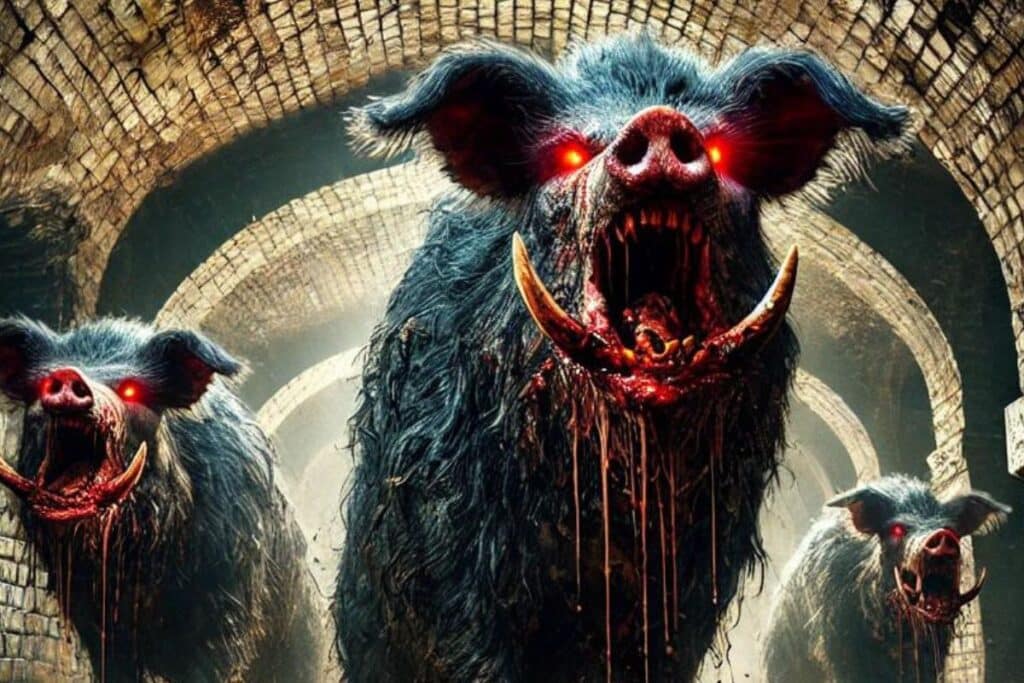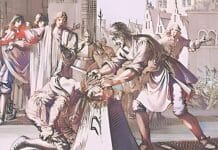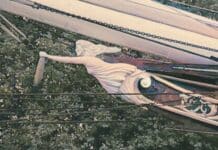19th-century London was gripped by the terrifying belief that monstrous black pigs prowled the sewers. RICHARD CLEMENTS tells us the chilling legend of the Black Swine.

London, with its deep history and sprawling subterranean network, has always been fertile ground for urban legends. One of the most intriguing and unsettling tales is that of the Black Swine, purportedly living in the Victorian-era sewers beneath Hampstead and beyond.
Emerging in the mid-19th century, this legend blends myth, urban anxiety, and the harsh realities of the time. Popularised by journalist Henry Mayhew, the story describes large black pigs thriving in the city’s sewage system, a narrative that captivated and horrified Victorian Londoners.
Where did the Legend of the Black Swine begin?
The legend of the Black Swine arose amid the chaotic, overcrowded, and unsanitary conditions of 19th-century London. The rapid expansion and industrialisation of the city overwhelmed its rudimentary sewer system, turning the Thames and other waterways into open sewers. In such an environment, the existence of hidden creatures was not difficult to imagine.
Henry Mayhew, known for his detailed documentation of London’s working poor, included accounts of sewer hunters – individuals who scavenged the sewers for lost valuables – in his seminal work, London Labour and the London Poor (1851).
According to these “toshers”, a pregnant sow had once found its way into the sewer system near Hampstead. She gave birth to piglets that thrived on the waste, becoming numerous and ferocious.
Although Mayhew himself was sceptical, he noted that many believed the tale of the sewer pigs. These pigs were said to avoid the surface, staying hidden in the sewer depths. The toshers, who endured the foul conditions of the sewers in search of treasure, reportedly feared these animals.
One particular account suggested that the pigs were never seen above ground because they swam against the current, attempting to reach the river but invariably turning back. This tale, though seemingly far-fetched, was told with such conviction that it gained a foothold in the public imagination.
An 1859 editorial in the Daily Telegraph further stoked the legend, warning that these pigs might one day emerge from the sewers to terrorise the city’s inhabitants. Such sensationalist reporting only deepened the story’s roots in London’s rich folklore.
To understand the plausibility of the Black Swine legend, it’s essential to consider the state of London’s sewer system before and after the mid-19th century. Before the construction of the modern sewer network by engineer Joseph Bazalgette, London’s sewers were open, exposed, and frequently overwhelmed by waste. The Great Stink of 1858, when the Thames became a reeking cesspool, prompted the creation of a modern underground sewer system.
The transition from open sewers to Bazalgette’s brick-lined tunnels marked a significant improvement, but the earlier conditions were still remembered by Londoners and provided fertile ground for urban myths. Livestock markets were common across London at the time, and animals often roamed the streets, making the idea of a pig wandering into the sewers not entirely implausible.
Laurence Ward, head of digital services at the London Metropolitan Archives, notes that Mayhew is frequently cited due to the scarcity of similar accounts of working-class life. While some aspects of Mayhew’s work are questioned, his stories offer valuable insights into the period’s urban legends.
The Sewer Hunters and Their World
The sewer hunters, or toshers, played a crucial role in both the economy and the folklore of Victorian London. Equipped with lanterns and long handled tools, they ventured into the sewers in search of coins, jewellery, and other lost items. Their dangerous and dirty work brought them into contact with all manner of urban waste, and their stories of monstrous pigs likely grew out of these grim experiences.
The toshers faced numerous threats from the unsanitary environment they worked in, such as potential cave-ins and swarms of rats. In such a setting, the idea of large black pigs roaming the sewers would have seemed just another hazard of their perilous occupation.
The legend of the Black Swine fits neatly into the broader tapestry of Victorian urban folklore, which often featured mysterious and terrifying creatures. Similar stories from the era include characters like Sweeney Todd, the demon barber, and Spring-heeled Jack, a supernatural attacker. Each of these legends reflects the anxieties and fears of a rapidly changing society.
The Black Swine, in particular, resonates with themes of pollution, overpopulation, and the unknown lurking beneath the surface of everyday Victorian urban life. Just as the tales of sewer alligators in New York captured the public’s imagination in the 20th century, the Black Swine of London’s sewers may have served as a metaphor for the uncontrollable aspects of urban life.
The legend of the Black Swine in Victorian London’s sewers is a fascinating example of how urban myths develop and persist. Rooted in the harsh and unsanitary conditions of the time, this story reflects the fears and imaginations of a population grappling with rapid industrialisation and urbanisation.
While there is no concrete evidence to support the existence of feral pigs in the sewers, the legend continues to captivate those who encounter it today, serving as a reminder of the hidden, often dark, corners of city life. Whether fact or fiction, the tale of the Black Swine remains a compelling part of London’s urban myths and rich folklore.
What do you think of the legend of the Black Swine and feral pigs in London’s sewers? Tell us in the comments section below!







